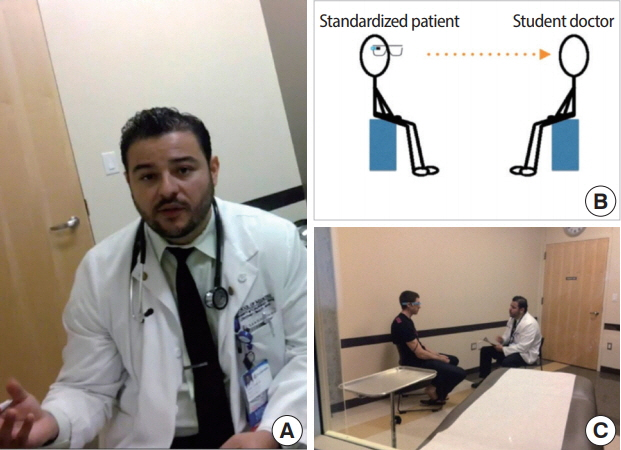J Educ Eval Health Prof.
2018;15:5. 10.3352/jeehp.2018.15.5.
Formative feedback from the first-person perspective using Google Glass in a family medicine objective structured clinical examination station in the United States
- Affiliations
-
- 1Department of Emergency Medicine, University of California, Irvine School of Medicine, Orange, CA USA. jyoum@uci.edu
- KMID: 2439261
- DOI: http://doi.org/10.3352/jeehp.2018.15.5
Abstract
- PURPOSE
This case study explored the use of Google Glass in a clinical examination scenario to capture the first-person perspective of a standardized patient as a way to provide formative feedback on students' communication and empathy skills "˜through the patient's eyes.'
METHODS
During a 3-year period between 2014 and 2017, third-year students enrolled in a family medicine clerkship participated in a Google Glass station during a summative clinical examination. At this station, standardized patients wore Google Glass to record an encounter focused on communication and empathy skills "˜through the patient's eyes.' Students completed an online survey using a 4-point Likert scale about their perspectives on Google Glass as a feedback tool (N= 255).
RESULTS
We found that the students' experiences with Google Glass "˜through the patient's eyes' were largely positive and that students felt the feedback provided by the Google Glass recording to be helpful. Although a third of the students felt that Google Glass was a distraction, the majority believed that the first-person perspective recordings provided an opportunity for feedback that did not exist before.
CONCLUSION
Continuing exploration of first-person perspective recordings using Google Glass to improve education on communication and empathy skills is warranted.
Figure
Reference
-
References
1. Brodkin J. Googlers skydive wearing Google Glasses, broadcast jump live to Google+. ArsTechnica [Internet]. 2012. Jun. 28. [cited 2018 Jan 15]; Tech. Available from: https://arstechnica.com/gadgets/2012/06/googlers-skydive-wearing-google-glasses-broadcast-jump-live-to-google/.2. Evans HL, O’Shea DJ, Morris AE, Keys KA, Wright AS, Schaad DC, Ilgen JS. A comparison of Google Glass and traditional video vantage points for bedside procedural skill assessment. Am J Surg. 2016; 211:336–342. https://doi.org/10.1016/j.amjsurg.2015.07.029.
Article3. Tully J, Dameff C, Kaib S, Moffitt M. Recording medical students’ encounters with standardized patients using Google Glass: providing end-of-life clinical education. Acad Med. 2015; 90:314–316. https://doi.org/10.1097/ACM.0000000000000620.
Article4. Moshtaghi O, Kelley KS, Armstrong WB, Ghavami Y, Gu J, Djalilian HR. Using Google Glass to solve communication and surgical education challenges in the operating room. Laryngoscope. 2015; 125:2295–2297. https://doi.org/10.1002/lary.25249.
Article5. Hashimoto DA, Phitayakorn R, Fernandez-del Castillo C, Meireles O. A blinded assessment of video quality in wearable technology for telementoring in open surgery: the Google Glass experience. Surg Endosc. 2016; 30:372–378. https://doi.org/10.1007/s00464-015-4178-x.
Article6. Brewer ZE, Fann HC, Ogden WD, Burdon TA, Sheikh AY. Inheriting the learner’s view: a Google Glass-based wearable computing platform for improving surgical trainee performance. J Surg Educ. 2016; 73:682–688. https://doi.org/10.1016/j.jsurg.2016.02.005.
Article7. Wald HS, Anthony D, Hutchinson TA, Liben S, Smilovitch M, Donato AA. Professional identity formation in medical education for humanistic, resilient physicians: pedagogic strategies for bridging theory to practice. Acad Med. 2015; 90:753–760. https://doi.org/10.1097/ACM.0000000000000725.
Article8. Lee CK, Kim Y, Lee N, Kim B, Kim D, Yi S. Feasibility study of utilization of action camera, GoPro Hero 4, Google Glass, and Panasonic HX-A100 in spine surgery. Spine (Phila Pa 1976). 2017; 42:275–280. https://doi.org/10.1097/BRS.0000000000001719.
Article9. Afghani B, Besimanto S, Amin A, Shapiro J. Medical students’ perspectives on clinical empathy training. Educ Health (Abingdon). 2011; 24–544.
- Full Text Links
- Actions
-
Cited
- CITED
-
- Close
- Share
- Similar articles
-
- The efficacy of peer assessment in objective structured clinical examinations for formative feedback: a preliminary study
- Is online objective structured clinical examination teaching an acceptable replacement in post-COVID-19 medical education in the United Kingdom?: a descriptive study
- An objective structured biostatistics examination: a pilot study based on computer-assisted evaluation for undergraduates
- New approach to learning medical procedures using a smartphone and the Moodle platform to facilitate assessments and written feedback
- Application of an objective structured clinical examination to evaluate and monitor interns’ proficiency in hand hygiene and personal protective equipment use in the United States


